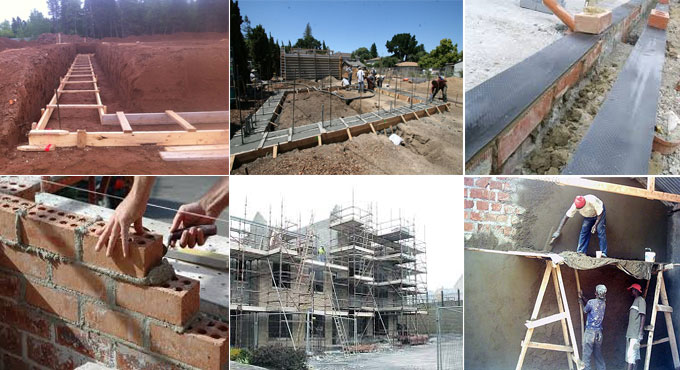
Some useful guidelines on residential building construction
Prior to commence the physical construction work at the jobsite, the following paper work should be completed :-
1. Arrangement of drawings according to needs of consumers.
2. Working out the material cost, labor cost & contingencies.
3. Sanction of drawings & appraisal from Client.
4. Sanction of drawings from City Development Authority. It plays a vital role as residential building drawings should satisfy the authority defined rules.
5. The construction work should be executed by either contractor or labor that is hired on each day basis.
6. Marking of plot boundaries.
7. Clean up of plot.
8. Arrangement of site layout based on the drawing.
Once the above documentation work is finished, physical construction on plot is started. Given below, the detailed steps :-
EARTH WORK: Normally excavation is accomplished for the construction of wall foundations. Excavation should be done on the basis of the drawings with lengths & widths. Once excavation is completed, layout the foundation and backfill the left over excavated area around foundation with soil.
Floor levels of residential buildings are larger as compared to the natural ground level. Fill the area with soil up to floor levels and compact the soil. Thus, the earth work of residential building is completed.
CONCRETE WORK IN FOUNDATION: It is essential to examine the levels of foundation prior to concrete work. Patches exist where excavated depth marginally surpasses and vice versa. Level the foundation base to equivalent level. After that, pour the concrete following the specifications of the drawing. Normally, the proportion of concrete remains 1:4:8 for foundation. Sometimes it remains as 1:5:10 or 1:6:20.
Here 1:4:8 signifies 1 part cement per cubic, 4 parts sand per cubic, 8 parts of coarse aggregates.
Depth of foundation differs from 9? to 18? and generally for most of the cases it is taken as 12?? depth. The width of foundation should be equivalent to its depth.
DAMP PROOF COARSE (D.P.C): To safeguard walls from moisture, a layer of damp proof coarse material should be provided at floor level with thickness 1 inch. The material of damp proof coarse layer comprises of concrete ratio 1:1.5:3 containing a mixture of water proof material 1kg/bag.
MASONRY WORK: Masonry work is executed with cement mortar (mixture of cement & sand). Proportion of cement mortar differs from 1:4 to 1:6. Here (1:6) signifies 1 part cement and 6 parts of sand. Dampen near about 25 bricks through a hose pipe and remove all loose dirt from the top of footing and dampen about a meter of surface at one end of the foundation through hose pipe. Put a mortar line just behind the threaded level line and place bricks on the mortar bed. Ensure bricks are properly placed as per the threaded horizontal level line.
LINTEL: Masonry work of buildings is done just one time till roof. Openings for windows & doors are abandoned during masonry works. Reinforced cement concrete beams should be arranged on the top of openings. So, those loads of structure over openings are not directly proceed to the door frames.
ROOFING: Roof slab of building is poured once masonry works are finished. Presently, reinforced cement concrete slab is used in roofing. Slab thickness & reinforcement details should be in line with sanctioned drawings.
PLASTERING & POINTING: Form work is detached after 14 days of slab pouring. After that, the plastering work is started. Mortar for plaster work normally remains 1:3 or 1:4. Thickness of plaster layer should not be in excess of 0.75inch. The surface should be cured for about 7 days in order that the plaster attains proper strength.
Normally, internal walls of buildings are covered with plastered layer and the outside walls with pointing. It is recommended to plaster the outside walls instead of pointing.
DOORS & WINDOWS: Generally, doors and windows made of woods are utilized. Now-a-days the doors are also constructed with steel & aluminum. For wooden doors & windows, frames are set in walls throughout masonry work. Panels are then secured with hinges after plaster work. Steel and aluminum doors are settled as soon as the paint work is finished.
SERVICES: Services play an vital role for single house. There are several types of services throughout construction which range from electricity supply, gas supply, water supply, sanitary etc. Conduits for electric supply are secured in walls prior to plastering. The water supply and sanitary lines are also arranged prior to pouring of building floor. The gas lines are not settled in walls or slabs. Gas line remains open in air.


